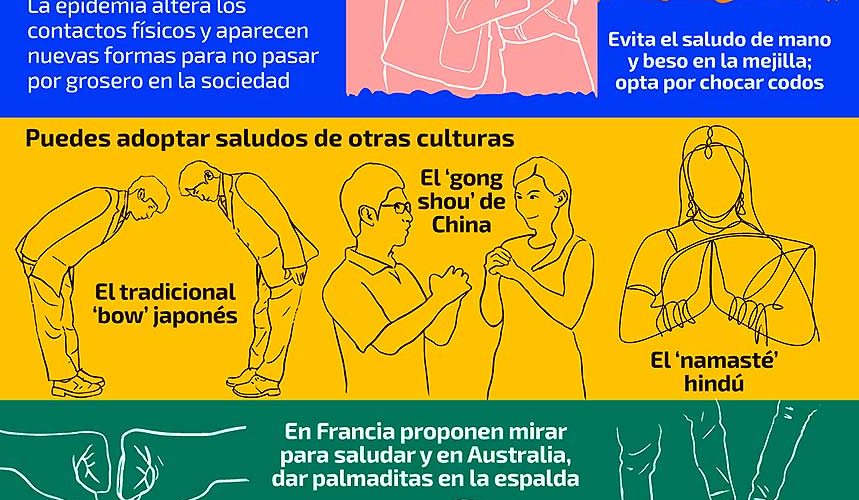From the Thai wai to the Zambian cup-and-clap, these no-contact salutes convey respect and welcome.
To prevent the spread of coronavirus, people around the world are trading their handshakes, hugs, and hongi (a traditional noses-pressed Maori greeting) for lower-risk gestures such as foot bumps and air high-fives. The current COVID-19 crisis is influencing ways people connect, but for some cultures, no-contact greetings already exist and are the result of deeply rooted traditions rather than pandemic protocol.
Namaste from India to Nepal
While you might hear the phrase “namaste” accompanied by a mudra (gesture) of upward-pointing, pressed-together palms, in Western pop culture it’s often stripped of its cultural context and inappropriately used. These days, the term is unceremoniously plastered on tote bags and T-shirts and uttered at the end of beer yoga classes, worlds away from its ancient spiritual origins.
“The history [of the gesture] dates back several thousands of years,” says Divya L. Selvakumar, a Hindu Indian American with familial origins in Tamil Nadu, and the founder of the American Hindu World Service. “It is mentioned in the Rig Veda, the oldest of the four Vedas [important Hindu texts].”
The Sanskrit term translates to “bend or bow to you,” and so, Selvakumar says, “a person bows [the head] slightly when doing namaste to another person to signify ‘the Divine within me bows to the same Divine within you.’ It is considered to be a sign of respect and gratitude.”
A sign of the times in New Delhi: The no-touch namaste serves as spiritual protection—and can help stem the spread of COVID-19.
There’s both humility and reverence in this greeting, and it’s believed that the mudra also protects the person earnestly performing it.
“By folding your hands together, you keep your energy protected and contained, as opposed to absorbing another person’s [energy],” explains Anjhula Mya Singh Bais, a trauma specialist and Nichiren Buddhist.
The wai in Thailand
The standard greeting across Thailand, the wai, also involves a gentle bow of the head with one’s hands pressed together in front—evidence of the influence of Hinduism and Buddhism on Thai culture, past and present.
“Many Hindus and Buddhists say prayers with their hands pressed together, using the wai,” says Amporn Marddent, a lecturer in the Cultural Studies Program at the Institute of Liberal Arts, Walailak University, in Nakhon Si Thammarat. “But the history of the wai also comes from the greeting to show that we are very open, we do not carry any kind of weapon, and we come in peace.”
In addition to its use in spiritual practice and greetings, the Thai wai has multiple other applications including dance performances, apologies, and even to avoid the wrath of playground bullies.
The Thai wai has many meanings beyond a polite “hello.” It is often used in dance performances and to express apologies.
“The meaning is quite fluid,” says Marddent, “but for the current time, when we greet with the wai we also follow by saying ‘sawatdee kha’ or ‘sawatdee krab’ (depending on our gender). So the wai also means hello in a very polite way.”
And since the wai doesn’t require contact, it makes for a safer salutation during the coronavirus pandemic. Even the director of the pandemic and epidemic diseases department of the World Health Organization, Sylvie Briand, recommended the Thai wai as an acceptable alternative to handshaking.
To convey a higher level of respect, use a deeper bow and place your hands higher: pressed hands at chest level for a standard greeting; face level for a colleague, elder, or a superior; hairline level for a monk. And if ever you see the King of Thailand, bow deeply and place your pressed hands high—thumbs at the top of your head.
Bowing in Japan
An obeisance, or gesture of deference, that began as an exclusive practice of the nobility more than a thousand years ago is now the most widely recognized non-verbal greeting of Japan.
“Bowing was introduced to Japan in the seventh century from China,” says Yuko Kaifu, president of Japan House Los Angeles, a cultural initiative of the Japan Ministry of Foreign Affairs. As a former foreign services officer, Kaifu was expected to understand and properly execute Japanese etiquette in her work as an interpreter for the likes of Japanese Empress Michiko and foreign dignitaries such as President Ronald Reagan and Princess Diana. “Bowing was initially confined to the noble class but became more prominent among the samurai warrior class from around the 12th century.” Kaifu says it didn’t permeate the commoners’ class until after the Edo period in the 17th century.
“Bowing originated to show the class difference…so that the person bowing would be bending the body to make themselves seem shorter,” says Mika White, CEO of Chapter White Inc., a Hiroshima-based destination marketing company.
The Japanese bow of today is not exactly the same as the one used then. White says it has “evolved into the modern bow, where people use this body language to greet each other.”
And when you bow now, you can keep your feet planted on the ground. In the past, Japanese lived in homes where tatami mats were the norm and bows were made from a seated position.
“It’s reflective of the change in lifestyle,” Kaifu says. “You’d sit with your knees bent [on the tatami mats under you] and then bow on your legs. Nowadays, we rarely sit in that style except when we attend tea ceremonies or other traditional practices.”
But the key component of the Japanese bow—lowering the head to a degree that matches your intended message—remains intact.
The bending of the body and lowering of the head convey “reverence to others,” Kaifu explains. “When you bow, you bow with your head down. You have no intention to assault or attack.”
And the degree to which you bend communicates your message. To say hello, the torso should be bent from the hips 15 degrees, White says. “To honor someone superior or to greet a client, 30 degrees. To show your deepest sorrow, respect, or apologies, 45 degrees.”
Here are some handshake alternatives suggested by National Geographic readers.
Although Kaifu says handshaking had also become common in Japan and, pre-pandemic, younger people likely bowed less than older people, the current concerns of coronavirus spread may lead to a larger comeback for the traditional greeting.
“People that used to handshake more than bow may be having a second thought about that,” Kaifu says. “I used to tell people [planning to travel to Japan] you don’t necessarily need to learn to bow because Japanese are used to shaking hands, too. But now, if I have another opportunity to teach Japanese etiquette, it would be safer and more appropriate to teach them to bow, no touch required.”
Cup and clap in Zambia
Shaking hands is commonplace in Zambia. But you can also communicate without physical contact, Zambia Ground Handlers team members William Banda of the Kunda ethnic group and Gerald Nyirenda of the Tumbuka ethnic group explain.
To say a simple hello, cup your hands together and clap a couple of times while saying “mulibwanji” (meaning “hello,” used any time of the day) or “mwakabwanji” (good morning).
If you’re meeting in-laws, you’ll need to take it a step further. While cupping your hands in the same way as the general hello, squat down low and clap in this position. Lowering your body while greeting conveys greater respect.
When you meet other elders, you can say hello by placing a hand on your chest and stomach and bending your legs slightly, almost in a curtsy.
Zambia is home to more than 70 ethnic groups, but Banda and Nyirenda say that these gestures are passed down through the generations and understood by all Zambians, from rural villagers to business people in cities.
Lakota avoidance practices
For some cultures, like the Lakota, intentionally avoiding contact can sometimes be used to convey respect.
Jennifer Weston, a member of the Lakota, grew up on the Standing Rock reservation, in South Dakota, and says that while a gentle, fingertip handshake is a common greeting in her culture, she was taught to refrain from physical and eye contact when greeting in-laws or cousins of the opposite gender.
“I always understood the avoidance practices as coming from a place of respect,” Weston says, “but also having to do with the large kinship networks that our communities lived in.” Kinship is at the heart of Lakota culture. Physical and eye contact avoidance “was a way to maintain appropriate boundaries. And maybe in close living quarters or in families that were multigenerational and may have shared living spaces—through different kinds of conditions in terms of winter seasons, for example—I think it was just part of a social order.”
Royal Lost His Blanket-Stone Jr., the director of the Lakota Studies Department at Sinte Gleska University in Rosebud, South Dakota, says “these deep-rooted family protocols on how each individual should treat another within the family infrastructure when it comes to eye contact or physical contact” are rooted in Lakota tribal laws and values that existed prior to Euro-American contact.
For some families, these protocols are still practiced today.
“Standing Rock is very multicultural and multireligious,” Weston says. “We have areas that are heavily influenced by Catholic traditions or Episcopalian or Congregationalist, for example. And then there are also families that are much more focused on traditional Lakota spirituality and ceremonies. Then there are families who have blended Christianity and Lakota spiritual practices as well. So it varies by family and depends on what’s passed down in each household.”
And, as Weston explains, the lack of interaction or physical affection in certain specified relationships does not equate to lack of love. On the contrary, she says, “We consider [these familial relationships] very treasured and valued. You’re supposed to have ultimate respect for them, especially if they’re not of the same gender as you. So it’s a relationship that you’re supposed to work very hard to preserve and maintain.”
The salaam of Islam
With an estimated 1.8 billion Muslims around the world, you can expect variations in the gestures that accompany the traditional salutation “as-salaam `alaikum” (“peace be upon you”).
Peace is at the core of Islam, and greeting is part of the spiritual practice, says Saifa T. Hussain, associate chaplain and advisor to the Muslim and Interfaith community at Middlebury College, in Vermont. “There’s this idea of a sacred greeting when you meet a brother or sister—that’s generally how Muslims consider their community. You’re part of an ummah, like a worldwide community that’s almost familial,” Hussain says. “There are deep bonds there, and the greetings and the etiquette behind that to foster that unity and love.”
While many “salaams” (greetings) do involve touch—it’s common within Muslim communities for members of the same gender or family to greet one another with a handshake, hug, and multiple cheek-side kisses—physical contact isn’t a requirement. In fact, there’s an awareness of physical touch inherent in Islam that informs the way people in the Muslim community approach greetings.
Humans and culture are complex, and the topic of touch reflects that.
“There are Hadith—prophetic narrations—where the Prophet Mohammed (peace be upon him) says that touching the opposite gender is forbidden,” Hussain says. She notes that there are other Hadith that some scholars interpret as a handshake between the Prophet and a circle of new Muslims that included women. And then there is the question of how queer and nonbinary believers apply the Hadith in their lives. Humans and culture are complex, and the topic of touch reflects that.
“There are different cultures and ways of being,” Hussain says. And regardless of religion, “it’s not necessarily a given that everyone feels comfortable hugging. People have discomfort with it [physical touch] for other reasons, too. In a multicultural campus or community, we should be aware that there are different etiquettes and different comfort levels with touch.”
A no-contact salaam may be the best place to start—out of respect for the personal boundaries or the religious or cultural values of the person you are greeting as well as for everyone’s health during the pandemic. You can do as many Muslims do—from Hussain’s own Muslim-American community to Arab cultures in places like Jordan to Muslim communities in Southeast Asia—and simply put your right hand to your heart when greeting.
Learn why keeping groups small can save lives in the era of COVID-19.
“The heart is seen as such an important, sacred symbol in the Islamic tradition,” Hussain says, “more important than the brain or mind. The heart is seen as where the seat of the soul is. That’s where your spiritual life is. It’s almost like touching your heart is seen as sacred. I’m saying ‘Peace be upon you’ and this [right hand to the heart] is a gesture recognizing the sacrality of you.”
Say hello to the future
What will greetings look like in a post-pandemic world? As we contemplate and reevaluate greetings—in our own communities and eventually in places where we travel again in the future—we may find that other interrelated issues, such as the role of gendered roots and spiritual practices, also rise to the surface. It all depends on what we choose to carry forward, adapt, or create together as we navigate this new normal.
Source: National Geographic








